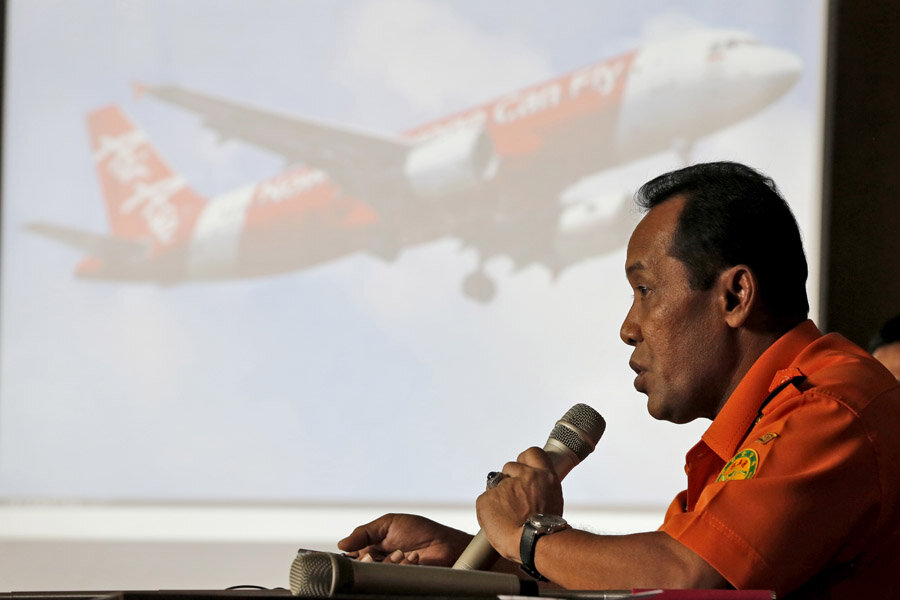AirAsia aircraft tail discovered in Java Sea
Loading...
| Pangkalan Bun, Indonesia
Divers and an unmanned underwater vehicle on Wednesday spotted the tail of the AirAsia plane that crashed into the Java Sea with 162 people on board, an important finding because the jet's all-important black boxes are located in that part of the aircraft.
Powerful currents and murky water continue to hinder the operation, but searchers managed to get a photograph of the debris — nearly 6 miles from where Flight 8501 lost contact Dec. 28 — after it was detected by an Indonesian survey ship, National Search and Rescue chief Henry Bambang Soelistyo told reporters.
One released image appeared to show an upside down "A'' painted on a piece of metal, while another grainy shot depicted some mechanical parts.
"Today we successfully discovered the part of the plane that became the main aim since yesterday," Soelistyo said. "I can ensure that this is part of the tail with the AirAsia mark on it."
Tony Fernendes, AirAsia's chief executive officer, welcomed the news.
If it is the right part of the tail section, he tweeted, then the cockpit voice and flight data recorders, or black boxes, "should be there."
He said the airline's priority still is to recover all the bodies "to ease the pain of our families."
The carrier, meanwhile, said families of those killed would be compensated in accordance with Indonesian laws.
Each will receive $100,000, Sunu Widyatmoko, president of AirAsia Indonesia, told reporters in Surabaya.
So far, 40 corpses have been found, including an additional one announced Wednesday, but time is running out.
At two weeks, most corpses will sink, said Anton Castilani, head of Indonesia's disaster identification victim unit, and there are already signs of serious decomposition. Officials are hopeful many of the more than 122 bodies still unaccounted for will be found inside the fuselage, which is believed to be lying near the tail.
The Airbus A320 went down halfway through a two-hour flight between Indonesia's second-largest city of Surabaya and Singapore, killing everyone on board. It is not clear what caused the crash, but bad weather is believed to be a contributing factor.
Just before losing contact, the pilot told air traffic control he was approaching threatening clouds, but was denied permission to climb to a higher altitude because of heavy air traffic. No distress signal was issued.
Finding the black boxes will be key to the investigation. They provide essential information about the plane along with final conversations between the captain and co-pilot. The ping-emitting beacons still have about 20 days before their batteries go dead, but high waves had prevented the deployment of ships that drag "ping" locators.
Sonar-equipped ships involved in the massive international hunt have identified what they believe to be the fuselage of the plane in recent days. Five other big objects have been found on the floor of the ocean, though no visual confirmation has been obtained yet. Smaller pieces of the plane, such as seats and an emergency door, have been collected from the surface.
The search area for bodies and debris was expanded this week to allow for the strong currents that have been pushing debris around, said Indonesian search and rescue operation coordinator Tatang Zainudin.
The water in the Java Sea is relatively shallow at 100 feet deep, but this is the worst time of year for a recovery operation because of monsoon rains and wind that create choppy seas and blinding silt from river runoff.
But in some ways, it is easier to find a missing plane compared to the extreme depths of the Indian Ocean, where searchers continue to hunt for Malaysia Airlines Flight 370, which disappeared last March with 239 people aboard.
"Because the Java Sea is such an enclosed basin, and there's not really big currents passing through it, everything just stays there for quite a while and the waves make it so that the sediment doesn't slowly sink to the bottom," said Erik van Sebille, an oceanographer at the University of New South Wales in Sydney, Australia. "It continuously keeps churning it up."
He said the conditions also make it particularly dangerous for divers because the water is dark and murky, making it easy for them to cut themselves on jagged wreckage or become snared and trapped. During the dry season, he added, it would likely be easy to see the plane underwater from the sky.
The area was land mass during the last Ice Age just 20,000 years ago, van Sebille said, meaning the ocean floor is likely to be relatively flat and still covered by a lot of organic material.
"This was just forest," he said. "Monkeys used to walk around here."





